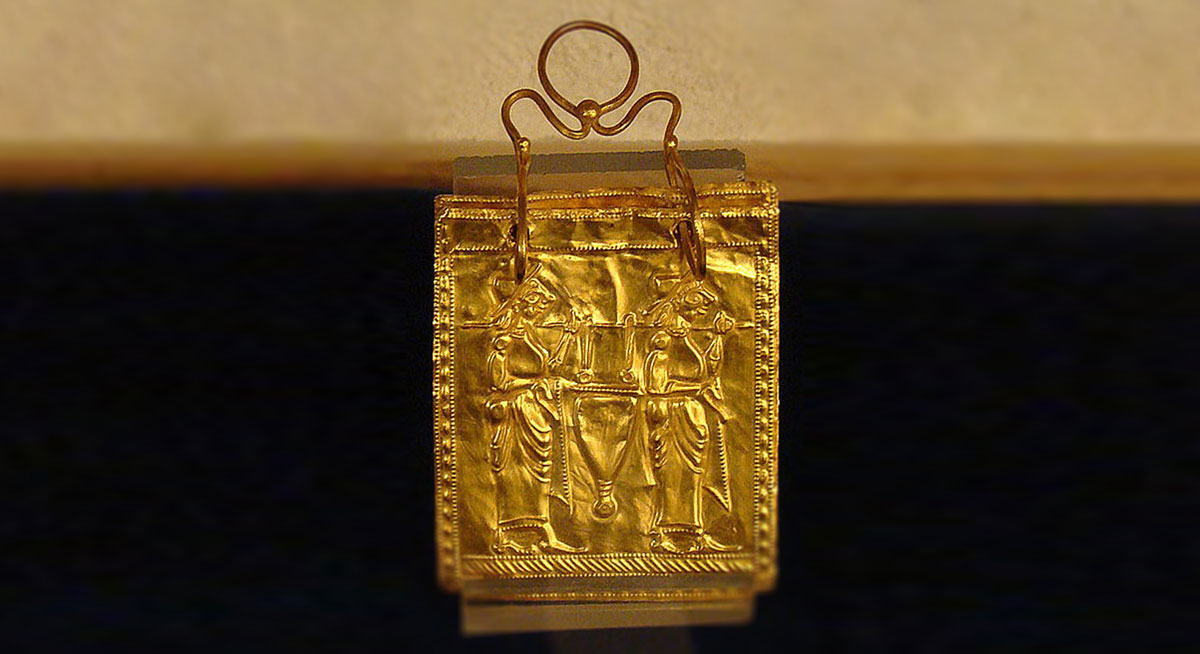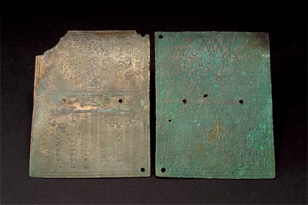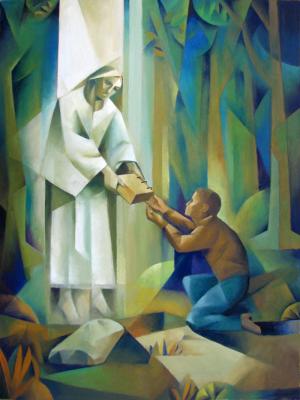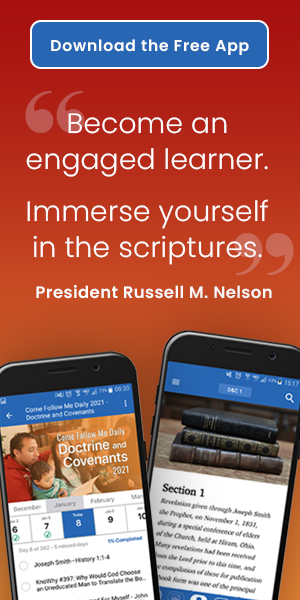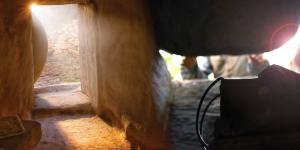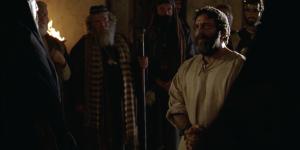You are here
Are There Other Ancient Records Like the Book of Mormon?

Mormon 8:16
The Know
For some, the story of the coming forth of the Book of Mormon has seemed too bizarre and fanciful to be believable. This was especially true at the time of its publication in 1830. People were suspicious of the claim that an ancient book written on golden plates had been revealed to a young farmer. It has taken nearly two centuries of archeological discoveries to fully demonstrate that the details of the buried Nephite record fit in exceptionally well with hidden books from all over the ancient world.
Hidden Records
Many passages in the Book of Mormon speak of it and other records being hidden up, often in the earth, in order to come forth to the world at a later time.1 According to John A. Tvedtnes, “The concept of hiding books for future generations to discover is [also] evident in a large number of early documents from the ancient Near East, whence came the peoples of the Book of Mormon.”2 The reports and legends contained in these documents stretch back to Adam himself.
When two rabbis, upon reportedly discovering a record hidden by Adam, said that a divine power stopped them from fully reading it,3 another rabbi explained that God “does not desire that so much should be revealed to the world, but when the days of the Messiah will be near at hand … it will be revealed to all, as it is written.”4 In “an early Jewish text … Moses instructed Joshua on how to preserve the books (parchments) he was leaving in his charge … and [to] deposit them in earthen jars until the day of recompense.”5 The Dead Sea Scrolls (some of which were found in earthen jars) the Nag Hammadi texts, and a host of other discovered documents confirm that many ancient records really were preserved for future generations.6
Metallic Plates, Stone Boxes, and Sealed Documents
The idea that the Book of Mormon was engraved onto golden plates and buried in a stone box, along with other sacred relics, was ridiculed by some people in the 19th century.8 Yet today, according to H. Curtis Wright, “literally thousands of metal documents” have been discovered from “all over the ancient world.”8
These include a variety of documents made from gold and gold alloys, some of which are from ancient America.9 The discovery of ancient hidden relics, many of them also made from precious materials, is also significant.10
An ancient Egyptian temple text “describes how to inscribe a text on a gold or silver lamella (plate) and place it ‘in a clean box.’”11 That such boxes were actually used to preserve documents and sacred relics is now widely attested throughout the ancient world.12 For instance, in 1854, “six small inscribed plates (gold, silver, bronze, tin, and lead, with one alabaster) were found in a stone box buried beneath [Sargon II’s] palace foundation.”13 In a 1933 excavation at “Persepolis, two pairs of [inscribed] plates (one silver and one gold in each pair) were found in stone boxes placed in the foundation corners of the palace.”14 And “in 1965 a set of nineteen inscribed gold plates was found in a bronze box.”15
Another seeming peculiarity of the Book of Mormon is that a portion of its plates were sealed.16 Legal scholar John W. Welch has pointed out that a number of ancient documents were also preserved in two parts—one part sealed and the other open—with both parts bound together in some fashion.17 These two-part documents were often legal in nature, validated by witnesses, and intentionally preserved for safe-keeping. These features have remarkable correspondences with the Book of Mormon.18
Mountains, Caves, and Angels
Mountains often symbolize temples or holy sanctuaries.19 Likely in relation with this theme, the Book of Mormon reports that several sacred revelations—including the Book of Mormon itself—were received, recorded, or buried in association with mountains or hills.20 Historical accounts indicate that many Nephite records were preserved in a hillside cave,21 and the Book of Mormon itself emphasizes that it would be “brought out of the earth” (Mormon 8:16).22 Joseph Smith said that an angel named Moroni had responsibility for the plates and led him to their buried location on a hill near his family’s farm (Joseph Smith—History 1:21–54).
Many ancient documents were also found or reportedly hidden in mountains or caves. For instance, the The Cologne Mani Codex indicates that “an angel brought Enosh to a mountain and instructed him to write on bronze tablets and hide his record.” In Russia, “twelve small gold plates” were reportedly found “in a hill.”23 In the Masonic tradition, the prophet Enoch “inscribed his revelation on a gold plate that he concealed in a temple he constructed inside a mountain.”24 And in a number of ancient texts, buried or hidden records or relics were guarded by an angel or some sort of divine power.25
The large set of documents collectively referred to as the Dead Sea Scrolls were found in caves surrounding the Dead Sea. In ancient Mesoamerica, caves held deep mythological symbolism and were often considered to be sacred.26 In 2005, Holley Moyes and James Brady noted that “only in the last decade have caves been widely recognized as ritual spaces by Mesoamerican archaeologists. Since caves in Mesoamerica were used almost exclusively for ritual, they provide an unrivaled context for studying pre-Columbian religion.”27 The Book of Mormon’s emphasis on caves and sacred records coming forth out of the earth fits right in with these findings.28
The Why
In light of post-1830 discoveries from all over the world, and especially from the Middle East, it can be seen that the Book of Mormon is at home in the ancient world. Doubled and witnessed legal documents, engraved golden plates, sealed records, stone boxes, sacred hillside repositories, caches of precious relics—all of these things are abundantly attested in antiquity, both archeologically and textually.
Not only can such discoveries strengthen our faith in the Book of Mormon, but they can also help us better understand and appreciate it. For instance, in our day it takes only a few moments to digitally upload or download what would have been a virtual wagonload of documents in the ancient world! Recognizing that Nephite prophets had to find precious ore, forge their own plates, carefully engrave each character, haul the heavy plates to safe locations, and create durable containers to protect them should increase our gratitude for the sacred writings they recorded and preserved.
The Book of Mormon is a testament to the faith and love of the Nephite prophets. The prophet Enos said he prayed that the Lord “would preserve a record of my people, the Nephites … that it might be brought forth at some future day” (Enos 1:13). In response, the Lord promised to fulfill this request in His “own due time” (v. 16). He also revealed to Enos that “Thy fathers have also required of me this thing; and it shall be done unto them according to their faith; for their faith was like unto thine” (v. 18).
These verses show that the Book of Mormon exists today because ancient prophets were concerned for future generations whom they would never meet in mortality. They truly cared about us. In turn, we ought to deeply care about them. Only when we recognize and accept the Book of Mormon as an ancient record can we gain the fullest understanding and appreciation for its sacred messages and the prophets who wrote them.
Further Reading
John A. Tvedtnes, The Book of Mormon and Other Hidden Books: Out of Darkness Unto Light (Provo, UT: FARMS, 2000).
John W. Welch, “Doubled, Sealed, Witnessed Documents: From the Ancient World to the Book of Mormon,” in Mormons, Scripture, and the Ancient World: Studies in Honor of John L. Sorenson, ed. Davis Bitton (Provo, UT: FARMS, 1998), 391–444.
H. Curtis Wright, “Ancient Burials of Metal Documents in Stone Boxes,” in By Study and Also By Faith: Essays in Honor of Hugh W. Nibley, Volume 2, ed. John M. Lundquist and Stephen D. Ricks (Salt Lake City and Provo, UT: Deseret Book and FARMS, 1990), 273–334.
Paul R. Cheesman, Ancient Writing on Metal Plates: Archaeological Findings Support Mormon Claims (Bountiful, UT: Horizon, 1985).
- 1. See 1 Nephi 20:6; 2 Nephi 27:12, 22, 26–27; 4 Nephi 1:48–49; Mormon 1:2; 4:23; 5:8, 12; 6:6; 8:4; Ether 4:3, 13, 15; 15:11, 33. See also, Book of Mormon Central, “What Were the ‘Other Records’ Nephi Saw in Vision? (1 Nephi 13:39),” KnoWhy 376 (October 26, 2017).
- 2. John A. Tvedtnes, The Book of Mormon and Other Hidden Books: Out of Darkness Unto Light (Provo, UT: FARMS, 2000), 11.
- 3. Joseph initially wasn’t able to obtain the gold plates because his heart was not right before the Lord. After locating the record, he “tried three times to take them out of the box, but suffered progressively stronger shocks that deprived him of much of his natural strength, until he exclaimed in frustration, ‘Why can I not obtain this book?’” H. Donl Peterson, “Moroni—,” Ensign, January 1992, online at lds.org. It took four years before he was prepared to receive them. See Joseph Smith—History 1:53.
- 4. Tvedtnes, The Book of Mormon and Other Hidden Books, 137.
- 5. Tvedtnes, The Book of Mormon and Other Hidden Books, 20.
- 6. Tvedtnes, The Book of Mormon and Other Hidden Books, 21, 167–174.
- 8. a. b. See William J. Hamblin, “Metal Plates and the Book of Mormon,” in Pressing Forward with the Book of Mormon: The FARMS Updates of the 1990s, ed. John W. Welch and Melvin J. Thorne (Provo, UT: FARMS, 1999), 20. Although some examples of metal plates had been discovered by Joseph Smith’s day, it’s likely that knowledge of these discoveries was mainly held by educated scholars and not the general public. See William J. Hamblin, “An Apologist for the Critics: Brent Lee Metcalfe’s Assumptions and Methodologies,” Review of Books on the Book of Mormon 6, no. 1 (1994): 462–470.
- 9. See William J. Hamblin, “Sacred Writing on Metal Plates in the Ancient Mediterranean,” FARMS Review 19, no. 1 (2007): 37–54; H. Curtis Wright, “Ancient Burials of Metal Documents in Stone Boxes,” in By Study and Also By Faith: Essays in Honor of Hugh W. Nibley, Volume 2, ed. John M. Lundquist and Stephen D. Ricks (Salt Lake City and Provo, UT: Deseret Book and FARMS, 1990), 273–334; Paul R. Cheesman, Ancient Writing on Metal Plates: Archaeological Findings Support Mormon Claims (Bountiful, UT: Horizon, 1985); Paul R. Cheesman, “Ancient Writing on Metal Plates,” Ensign, October 1979, online at lds.org; H. Curtis Wright, “Metallic Documents of Antiquity,” BYU Studies Quarterly 10, no. 4 (1970) 457–477; Daniel Johnson, “Metals and Gold Plates in Mesoamerica,” BMAF presentation, 2010, online at bmaf.org; Franklin S. Harris Jr., The Book of Mormon: Message and Evidences (Salt Lake City, UT: Deseret News Press, 1953), 95–105; John A. Tvedtnes and Matthew Roper, “One Small Step,” FARMS Review 15, no. 1 (2003): 160–169; H. Curtis Wright, Modern Presentism and Ancient Metallic Epigraphy (Salt Lake City, UT: Wings of Fire Press, 2006).
- 10. See Tvedtnes, The Book of Mormon and Other Hidden Books, 109–126. The reason additional relics are relevant is because the plates were preserved along with the Nephite interpreters and breastplate. And when the Three Witnesses were granted a view of the plates, they also beheld other Nephite relics, including the breastplate, interpreters, liahona, and sword of Laban (see Doctrine and Covenants 17:1).
- 11. Tvedtnes, The Book of Mormon and Other Hidden Books, 36.
- 12. See Tvedtnes, The Book of Mormon and Other Hidden Books, 31–58.
- 13. Tvedtnes, The Book of Mormon and Other Hidden Books, 43.
- 14. Tvedtnes, The Book of Mormon and Other Hidden Books, 44.
- 15. Tvedtnes, The Book of Mormon and Other Hidden Books, 36.
- 16. See Title Page; 2 Nephi 26:17; 27:7–21; 30:3; Ether 3:27; 4:5; 5:1; Moroni 10:2.
- 17. See John W. Welch, “Doubled, Sealed, Witnessed Documents: From the Ancient World to the Book of Mormon,” in Mormons, Scripture, and the Ancient World: Studies in Honor of John L. Sorenson, ed. Davis Bitton (Provo, UT: FARMS, 1998), 391–444; John W. Welch and Kelsey D. Lambert, “Two Ancient Roman Plates,” BYU Studies 45, no. 2 (2006): 55–76.
- 18. See Book of Mormon Central, “Why Would a Book Be Sealed? (2 Nephi 27:10),” KnoWhy 53 (March 14, 2016).
- 19. See 2 Nephi 12:2–3; cf. Isaiah 2:2–3.
- 20. See 1 Nephi 11:1; 1 Nephi 18:3; 2 Nephi 4:25; Mormon 1:3; Mormon 4:23; Mormon 6:6; Ether 4:1; Ether 15:11.
- 21. A number of individuals claimed that Joseph Smith and Oliver Cowdery visited a cave that was filled with Nephite records and artifacts. However, it is difficult to tell, from these reports, whether the experience was in vision or whether they visited the cave in person. See Cameron J. Packer, “Cumorah’s Cave,” Journal of Book of Mormon Studies 13, no. 1–2 (2004): 50–57, 170–71.
- 22. Emphasis added.
- 23. Tvedtnes, The Book of Mormon and Other Hidden Books, 129.
- 24. Tvedtnes, The Book of Mormon and Other Hidden Books, 129.
- 25. Tvedtnes, The Book of Mormon and Other Hidden Books, 75–108.
- 26. See Diane E. Wirth, “Revisiting the Seven Lineages of the Book of Mormon and the Seven Tribes of Mesoamerica,” BYU Studies Quarterly 52, no. 4 (2013): 77–88.
- 27. Holley Moyes and James E. Brady, “The Heart of Creation, the Heart of Darkness: Sacred Caves in Mesoamerica,” Expedition 47, no. 3 (2005): 31. See also Holley Moyes, ed., Sacred Darkness: A Global Perspective on the Ritual Use of Caves (Boulder, CO: University Press of Colorado, 2012).
- 28. Most notably, the Book of Mormon emphasizes that “great and marvelous were the prophecies of Ether” who “dwelt in the cavity of a rock [as] he made the remainder of this record” (Ether 13:13–14).
KnoWhy Citation
Related KnoWhys
Subscribe
Get the latest updates on Book of Mormon topics and research for free

